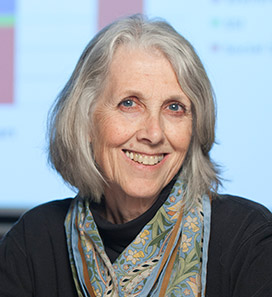Thanksgiving is this Thursday, and while we may have different traditions or favorite dishes, togetherness is a key ingredient for the holiday. Experts from the USC Leonard Davis School of Gerontology share their thoughts on how to make this Thanksgiving safer, healthier, and more social as loved ones gather together.
The importance of reaching out to others

Mary Pickford Foundation Professor of Gerontology Kate Wilber
Humans are social beings who need connectivity with others, but social isolation is a pervasive problem, especially among older adults, says Kate Wilber, the Mary Pickford Foundation Professor of Gerontology at USC Leonard Davis. More than one fourth of people age 65 and older live alone, and almost half of all women age 75 and older live by themselves.
“Although it is important to avoid simplistic assumptions and stereotypes and recognize that many people who live alone choose to do so and are fully engaged with friends and family, living alone has been identified as a major risk factor for social isolation and loneliness,” Wilber says.
“During the holidays, it is important to be aware that older adults who live alone are more vulnerable for food insecurity, poor energy intake, and depression. Feeling socially connected has especially important implications for women who live alone, as maintaining contacts with friends and relatives is a significant protective factor against decline in psychological well-being and the delayed onset of disabilities.”
Thanksgiving is the perfect time to reach out to someone who may be feeling isolated and offer an invite to holiday celebrations, hot meals, or other support, she adds.
“A sense of place, connectivity and community are critical to all of our lives,” Wilber says. “The holidays give us a chance to catch our breath, be together, and recognize how important and meaningful this is. For many of us, this is especially true this Thanksgiving.”
Safely navigating the year’s biggest traveling days

UPS Foundation Professor of Gerontology, Policy and Planning Jon Pynoos
Thanksgiving is the one of the busiest holidays for travel, but transit stations and airports can pose fall risks for older adults visiting loved ones, says Jon Pynoos, UPS Foundation Professor of Gerontology, Policy and Planning at the USC Leonard Davis School.
Older adults and others at risk for falling should always look for handrails or handholds to help keep themselves steady when moving around a vehicle, and taking seats near the front of the plane or near the doors on a train or bus can make boarding and disembarking easier. Don’t be afraid to ask for help from other riders, the bus driver, airline employees, or others if it’s needed, he says.
“Throughout your travels, take your time and be aware of your surroundings. Distraction and rushing increase the risk of falling,” Pynoos says.
Conversely, if someone is visiting the home of an older loved one this Thanksgiving, they can keep an eye out for fall risks around their home.
“Many of us will be visiting loved ones’ homes for the holidays. This presents an opportunity to do a quick check for fall risks,” Pynoos adds. “There are a number of simple home assessments available, from simple to more comprehensive.” See a list of resources from the Fall Prevention Center of Excellence here.
Make mealtime healthier and more memorable

Associate Professor Cary Kreutzer, MSNHL Program Director
The Thanksgiving feast can be both hearty and healthy, and it can do more than just fill bellies—it can bring back warm memories and make newcomers to the table feel truly welcome, says USC Leonard Davis faculty member and registered dietitian Cary Kreutzer.
Kreutzer, director of the USC Leonard Davis Master of Science in Nutrition, Healthspan and Longevity Program, encourages people to try new flavor sensations and to not be afraid to swap out dishes for potential undiscovered family favorites. Lots of healthy foods are now in season, from apples and pomegranates to walnuts and brussels sprouts, and can provide inspiration for fresh new holiday dishes.
Kreutzer also encourages Thanksgiving hosts to not forget about their guests that may have special dietary requirements, from individuals who are vegetarian or vegan to those who need to avoid certain allergens. Asking about dietary requirements ahead of time can help hosts add safe options to the menu and help guests feel welcomed and accommodated, she says. And if one wants to make absolutely sure guests’ dietary needs are met, placing small recipe cards with each dish in the buffet line can help guests pick safe foods, she adds.
A great way to introduce new dishes to the Thanksgiving table is to have a potluck cook-off, where attendees bring a new dish to share with others, she suggests. Getting family members to help with meal preparation and talking about the recipes over dinner is a great way to share the Thanksgiving workload and slow down the dinner with fun conversation.
Another great conversation starter to help everyone slow down, relax, and enjoy the meal is a Thanksgiving “sharing tablecloth,” where everyone can write about their gratitude on the tablecloth, then look back each year at their previous answers and talk about their memories, Kreutzer says.
“A sharing tablecloth can bring back memories and create conversation,” she says. “Each guest can write what they are thankful for this year, and younger guests can draw pictures.”





